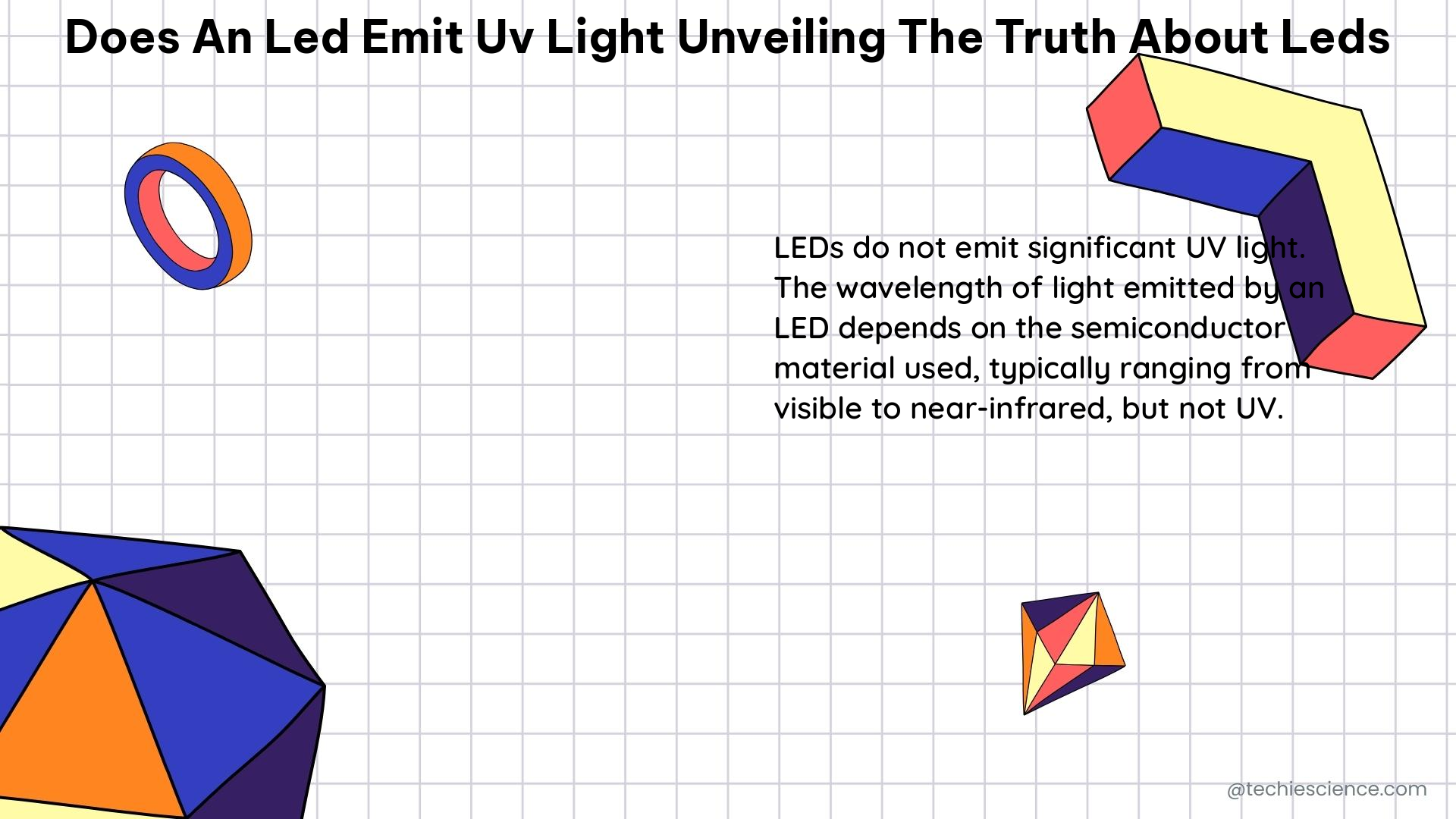Summary
Light-emitting diodes (LEDs) have become increasingly popular in various lighting applications, from household illumination to commercial and industrial settings. However, there is a common misconception that LEDs emit harmful ultraviolet (UV) radiation. In this comprehensive guide, we will delve into the technical details and unveil the truth about the UV emission characteristics of LEDs, providing a thorough understanding for electronics students and enthusiasts.
Understanding UV Radiation and LED Emission

Ultraviolet (UV) radiation is a type of electromagnetic radiation with wavelengths shorter than that of visible light, ranging from 100 to 400 nanometers (nm). UV radiation is further divided into three categories:
- UVA (315-400 nm): These longer wavelength UV rays are generally considered the least harmful and are often used in black light applications.
- UVB (280-315 nm): These medium-wavelength UV rays can cause sunburn and are associated with an increased risk of skin cancer.
- UVC (100-280 nm): These shorter wavelength UV rays are the most energetic and can be harmful to living organisms, but they are typically absorbed by the Earth’s atmosphere and do not reach the surface.
When it comes to LED light sources, the primary concern is the potential emission of UV radiation, particularly UVB and UVC, which can be harmful to human health.
LED UV Emission Characteristics
-
UVA Emission: LEDs primarily emit UVA radiation, which has a longer wavelength and is generally considered less harmful in low doses. The amount of UVA radiation emitted by LED lights is relatively low compared to other light sources, such as sunlight or tanning beds.
-
UVB and UVC Emission: Most commercial LED lights do not emit significant amounts of UVB or UVC radiation. These shorter wavelength UV rays are typically filtered out during the manufacturing process, as they can be harmful to human health.
-
LED Black Lights: While LEDs can be designed to produce light at specific wavelengths, including those in the UV range, black light LED sources are typically in the 385-400 nm range, which is considered the sweet spot for creating the optimal black light effect.
-
UV Emission in LED Lamps: Standard LEDs do create a small amount of UV radiation, but the actual amount of UV they emit is even less due to the phosphors within an LED lamp that convert the UV light to white light. This conversion process significantly reduces the overall UV emission from LED lamps.
-
Inverse Square Law and UV Intensity: The intensity of UV radiation, like any other form of light, follows the inverse square law. This means that as the distance from the light source increases, the intensity of the UV radiation decreases dramatically. For example, a 1-watt light source may be too bright at a distance of 1 centimeter, but it would be almost a pinpoint of light from several meters away.
UV Exposure and Human Health Considerations
-
Sunburn and Skin Damage: Exposure to UV radiation, particularly UVB and UVC, can lead to sunburn and other skin damage, such as premature aging and an increased risk of skin cancer.
-
Eye Problems: Prolonged exposure to UV radiation can also cause eye problems, including photokeratitis (also known as “welder’s flash” or “arc eye”) and cataracts.
-
Immune System Weakening: UV radiation can weaken the immune system, making individuals more susceptible to infections and other health issues.
-
Artificial Light Sources and UV Exposure: While it is important to be aware of the potential risks of UV radiation, most artificial light sources, including LED lamps, do not emit enough UV radiation to pose a significant health concern for the average person in a typical indoor setting.
Conclusion
In summary, while LEDs do emit a small amount of UV radiation, the levels are generally considered minimal and within safe limits. The phosphors within LED lamps effectively convert most of the UV light to white light, significantly reducing the overall UV emission. This makes LEDs a safer choice for prolonged exposure in household and office settings compared to traditional incandescent bulbs and some compact fluorescent lamps (CFL bulbs).
By understanding the technical details and the truth about LED UV emission, electronics students and enthusiasts can make informed decisions when selecting and using LED lighting solutions, ensuring their safety and well-being.
References
- Do LED Lights Emit UV Radiation?
- LED Lights and UV Rays
- Lighting and UV Radiation
- Do LED Lights Produce UV? LED Tanning Beds
- Do cool white LEDs emit UV light?

The lambdageeks.com Core SME Team is a group of experienced subject matter experts from diverse scientific and technical fields including Physics, Chemistry, Technology,Electronics & Electrical Engineering, Automotive, Mechanical Engineering. Our team collaborates to create high-quality, well-researched articles on a wide range of science and technology topics for the lambdageeks.com website.
All Our Senior SME are having more than 7 Years of experience in the respective fields . They are either Working Industry Professionals or assocaited With different Universities. Refer Our Authors Page to get to know About our Core SMEs.